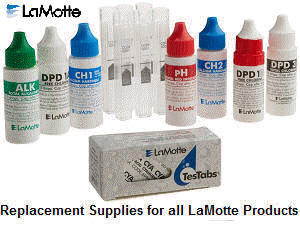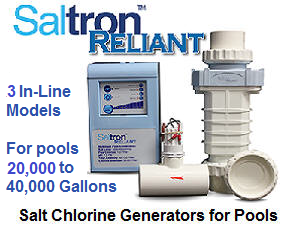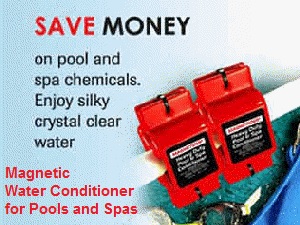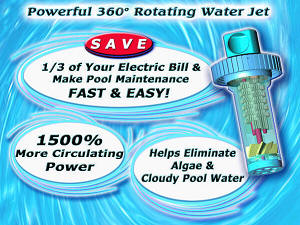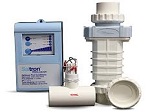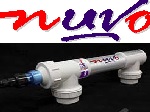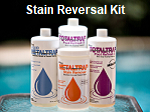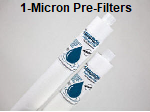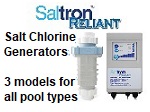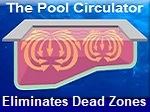|
 |
Shipping is FREE* . . . within
the Continental U.S.
A $9.99
handling charge will apply
to Continental U.S. Orders,
under $75.00. Orders
outside of the Continental
U.S. may require some
additional charge, based on
quantity and destination.
Most products can be
shipped World-Wide. International
and orders outside of
Continental U.S. - see
comments on the ordering
pages. |
|
 |

Major
Credit Cards and PayPal are accepted. |
|
On-line
shopping since 2002 - Safe and Secure!!! |
|
Managing the Calcium Hardness, of pool
water!!! |
|
Calcium
Hardness is an important component of
pool water chemistry and should be
monitored on a monthly or as-needed
basis.
A
ColorQ 2X is a 2nd generation,
Bluetooth, Waterproof, all-digital tester,
that can
measure all the common test factors.
There is a model, for every sanitizing
need. Reliable water testing helps
solve and avoid problems and requires
fresh
Test
Kit Replacements.
The
WaterLink SpinTouch Labs are the
ultimate, doing up to 10 different water
test factors, in just 1 minute. |
|
|
If you have a pool or spa water
testing need, we should have the
product.
►
Scroll down to read through some
Question & Answer information.
◄
|
|
How to manage calcium
hardness levels!!! |
Calcium is a
naturally occurring mineral that is frequently
found in high concentrations: such water is
called "hard" water. Calcium hardness chemistry
is one of the important pool water parameters
and its control is important, to help assure
proper water quality and help avoid certain pool
water problems. The preferred ranges, in
swimming pools, are 80-150 PPM in a vinyl pool
and 150-200 PPM in a masonry finish pool. Low
levels of pool water calcium hardness (soft
water) can lead to the problems of corrosive
water conditions. Chemicals are available to
raise the calcium hardness, as might be
necessary. High pool water calcium hardness
levels, especially above 400 PPM, can lead to
possible pool water clarity problems and scaling
conditions. Chlorine products containing calcium
hypochlorite raise the hardness level, each time
the product is added. Discontinuing such product
usage can help avoid further unwanted increases
in the calcium hardness. Various chelating or
sequestering Mineral Treating Products are
available to help deal with the problems
associated with high calcium hardness levels.
Pool water calcium levels can be determined by a
simple water analysis. This is especially
important with well water, as other problematic
minerals might be present and could require
treatment. Pool Water Magnetizers, also called
Magnetic Water Conditioners, have been reported
to help reduce and eliminate scale formation, by
inducing a positive electrical charge in the
water passing through the return lines.
If problems arise, refer to the
Pool Problems Page, as
a source of problem-solving information, broken down into
various categories. Scroll down the page and click on the linked
keywords,
catch phrases
or images, in the archived answers below, to access additional information, on that topic or product.
Do you know what's in
your water? If you're having problems, with hard
or soft water, testing allows you to better understand the
chemistry and determine the cause of the problem. Once
understood, you can select the best treatment option, such
as the addition of a Magnetic
Water Conditioner.
Understanding the nature of the problem, should be step
one. For information about our full selection of
testing options, visit our
Test Equipment Store.
 |
Join our E-Letter Mailing List.
You'll receive 1-3 E-Letters a
month, featuring helpful pool
and spa advice, new product
information and sale
announcements. All we
require is your e-mail address
and you can opt out anytime you
wish.
Your information
will never be shared or sold. |
|
▼
Helpful,
Problem-Solving Information, in a question and
answer format.
▼ |
►
Pool Scale Deposits?
I've noticed a white hard deposit
along the water line on the tiles. Our guess is that it may
be calcium deposits. If that's the case, what would be an
appropriate way to get rid of the deposits and to prevent it
from happening again? In one of your answers we read your
suggestion about using Mineral Treatment and lowering the
overall pH (to 7.2 or so). Would this be advisable to do in
our case as well? Are there any specific recommended brands
for the Mineral Treatment and how do you use it? Thanks!
Juan C., 4/12/2018
Most likely the
deposits are calcium scale. This pool problem is most likely
due to the water reaching the saturation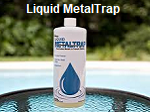 point, so far as calcium hardness is concerned. These
deposits can removed using a strong muriatic acid solution.
Apply with a sponge and make sure to wear rubber gloves and
eye protection. First, test in a small area to see how it
will affect the deposits and the tile. If your calcium
hardness level is above 400 PPM, you will have to add a
quality, phosphate-free mineral treatment, such as
Liquid MetalTrap - possibly
several times the suggested dose - in order to try and avoid
a recurrence. Your local pool professional should be able to
suggest a product. Keeping the pH closer to 7.2 and the
total alkalinity closer will, also, help reducing the
scaling tendencies of the pool water. For more information
on the topic, refer to the "Langelier
Index" page. The addition of a Magnetic Water
Conditioner might be able to help resolve some of the
scaling issues. I hope that
this
recommendation works out for you.
point, so far as calcium hardness is concerned. These
deposits can removed using a strong muriatic acid solution.
Apply with a sponge and make sure to wear rubber gloves and
eye protection. First, test in a small area to see how it
will affect the deposits and the tile. If your calcium
hardness level is above 400 PPM, you will have to add a
quality, phosphate-free mineral treatment, such as
Liquid MetalTrap - possibly
several times the suggested dose - in order to try and avoid
a recurrence. Your local pool professional should be able to
suggest a product. Keeping the pH closer to 7.2 and the
total alkalinity closer will, also, help reducing the
scaling tendencies of the pool water. For more information
on the topic, refer to the "Langelier
Index" page. The addition of a Magnetic Water
Conditioner might be able to help resolve some of the
scaling issues. I hope that
this
recommendation works out for you.
Sincerely. Alan Schuster, 4/12/2018
► Ryznar Stability
Index?
What is the Ryznar Stability Index and
how does it help protect heaters and other equipment, from
corrosion?
Austin S., 8/15/2020
An article appeared in the 8/12/11 issue of Pool and Spa News
about the Ryznar Stability Index. This index is favored, by some
heater and equipment manufacturers, because it affords
greater protection against corrosion, than does the more
familiar Langelier Index. It favors higher calcium hardness
levels and/or higher pH levels. While this will lessen the
possible the corrosive effects of softer, lower pH water, it
comes at a price. It boosts the calcium hardness to a point,
where scale begins to form, which actually helps protect the
equipment, from corrosion. However, as scale forms in the
heater, it reduces the efficiency, by acting as an
insulator. In a filter, it acts to cement the filter media,
reducing the effectiveness of the filter. In areas of the
southwest, the water is already too hard, right out of the
tap and it is challenging to main a clear pool, without
excessive scaling. For more information, go to this website
page: Ryznar Stability Index I hope that this information
will help you better protect your pool equipment.
Sincerely. Alan Schuster 8/19/2020
► Scale
Deposits In A Pool Heater?
I read somewhere that very high pool
water calcium hardness and pH can lead to scale formation
and that scale can form on the underwater surfaces,
including in the heater. My water has over 500 PPM of
calcium hardness. I have a solar heater. I don't see any
real evidence of scale. Every once in a while, I get cloudy
water. Is there something I can do to avoid a potential
problem? Please help.
J.M., 7/22/2017
A calcium hardness level of 500 PPM can definitely lead to
scale formation and it can take place in your solar heater
or any other type for that matter. If so, it will reduce
the heater efficiency, by acting as a layer of insulation.
Make sure that you keep the pH closer to 7.2, than to 7.6.
Try and lower the total alkalinity to within 80-120 PPM, if
practical. Stop all use of products containing calcium. Add
a quality Mineral Treatment, in order to help sequester the
calcium, on a regular basis. This treatment can actually
slowly dissolve calcium scale deposits, over a period of
time. There's nothing in your letter that positively
indicates that you have a problem, at this time. But, some
prevention does make sense. To confirm the overall
pool water chemistry, visit a pool store that has a very
reliable, professional lab such as a
WaterLink SpinTouch Lab,
as opposed to a less accurate test kit or strip
reader. I hope that I have been
helpful.
other type for that matter. If so, it will reduce
the heater efficiency, by acting as a layer of insulation.
Make sure that you keep the pH closer to 7.2, than to 7.6.
Try and lower the total alkalinity to within 80-120 PPM, if
practical. Stop all use of products containing calcium. Add
a quality Mineral Treatment, in order to help sequester the
calcium, on a regular basis. This treatment can actually
slowly dissolve calcium scale deposits, over a period of
time. There's nothing in your letter that positively
indicates that you have a problem, at this time. But, some
prevention does make sense. To confirm the overall
pool water chemistry, visit a pool store that has a very
reliable, professional lab such as a
WaterLink SpinTouch Lab,
as opposed to a less accurate test kit or strip
reader. I hope that I have been
helpful.
Sincerely. Alan Schuster, 7/23/2017
► Low
Hardness And Leaching?
We were told if the pool calcium level
was too low it would cause a leaching problem. Is this
correct and what is leaching?
Cindy J., 6/20/2010
At the optimum ranges for pH and total alkalinity and at a
given water temperature, the pool water can keep in
solution, without a problem, up to approximately 200-400 PPM
of calcium hardness. If the water is soft (low hardness) the
pool water will dissolve enough calcium minerals from the
walls of masonry pools to raise the calcium hardness into
this range. This process is called leaching. In the course
of this happening, over time, it can be difficult to
maintain the pH and total alkalinity. For this reason, it is
advisable to raise the hardness to approximately 200 PPM, by
adding sufficient calcium hardness increaser. I hope that
this information will prove helpful. Enjoy the summer.
Sincerely. Alan Schuster, 6/20/2010
► Unsure
About Test Colors?
I use a drop type test for calcium
hardness and total alkalinity and am left feeling unsure
about what the test results should be. The colors don't seem
to match up properly. Any suggestions?
David F., Mesa, AZ 5/2/2007
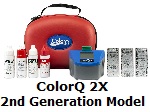
Some people have difficulty seeing slight differences in
colors and that could be part of the problem. In addition,
the testing chemicals may in need of replacement or may not
be the right ones for your tester. While these tests are not
as crucial as pH or chlorine, you still want reliable
results. The TA should be about 80-150 PPM. The calcium
level for a vinyl pool should be about 80-200 PPM and about
150-250 PPM for a masonry pool. To achieve more reliable
test results and eliminate all color matching, you might
consider using the
all-digital ColorQ
2X PRO 7 Water Analyzer.
It does 7 of the common, most important pool tests and is
ideal for people with color vision difficulties. I hope that
this information will prove useful.
Sincerely. Alan Schuster, 5/3/2007
► Hardness
and
Magnetic Water Conditioners?
Magnetic water conditioning sound like
a good idea. I've read that one of the benefits is that they
may eliminate hard water problems, but is it possible that
they will make the water too soft I've got a plaster pool
with hardness of 160, TA of 155, pH 7.4. I don't want
hardness to drop and would like to know if a magnetic water
conditioner will lower the hardness. Many Thanks,
Cheryl, Springfield, VA, 5/31/2010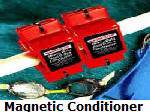
The Magnetizer Water Conditioner will not lower your
hardness level or create issues dealing with etching or
corrosion of the plaster. It uses magnetic energy to allow
the calcium to avoid forming scale deposits and helps make
overall water chemistry easier. Your pool water is will
probably increase in hardness, as times go by and the
Magnetizer will help prevent future problems. It is simple
to install and requires no energy or power source. I hope
that this information proves helpful.
Sincerely. Alan Schuster, 5/31/2010
► Erratic
Scaling?
We have a new pool that has what looks
like scale deposits. The automatic cleaner looks like a
glazed donut, the filter for the pool is as hard as a rock.
Is there any specific reason for this? Sincerely.
Jacqui, Florida, 2/2/2017
Three factors contribute to scaling conditions: high calcium
hardness (usually over 400 PPM), high pH (usually over 7.8)
and total alkalinity (usually over 200 PPM). All three
together can make it even worse. You can lower the pH and TA
with acid. The calcium hardness might be controlled, but not
necessarily lowered, by adding a calcium sequestering agent.
I suggest that you test the water for pH, TA and calcium
hardness. The Langelier Index will tell you if the water is
scale forming and help indicate how improve the situation.
Needless to say, avoid using products that contain calcium.
I how that I have been helpful.
Sincerely. Alan
Schuster, 2/2/2017
► Magnetic
Water Conditioner For Scale?
We live in AZ with well water and are
constantly battling our pH levels and dealing with scale
buildup. I'm interested in purchasing The Magnetizer, but
there are no specifications on the diameter pipe it will
fit. I've got a 2" return line.
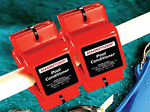
Cale C., Arizona, 4/10/2007
The Magnetic Water Conditioner
simply clamps around the pipes and should accommodate all of
the pipes used in residential pools and spa. I apologize
that that was not pointed out on the website. It will be added to that
page. I hope that I have been helpful. If so, please tell
your friends and dealers about the website.
Sincerely. Alan Schuster, 4/11/2007
► More Scale
Deposits?
Alan, I researched your site and could
not find an answer to my problem. I have an above ground
24' pool. We live in Myrtle Beach, SC. The pool is about 4
years old and this is the first time this problem has
arose. The pool is completely shut down and shut off every
fall. While preparing to open the pool for this season I
noticed scale on the walls of the liner. I did not try to
balance the water because I know the scale will not come off
if the pH is normal. At this time the pool water tests
corrosive. Water condition is cloudy with some blue green
algae. My problem is the scaling, I have brushed and
brushed, but it doesn't seem to be helping. Any other
products or solutions to address this? Thanks.
Scott, Myrtle Beach, SC, 4/18/2010
It does seem likely that you are experiencing calcium scale
deposits. However, without specific pool water analysis
data, I will have to make assumptions and generalizations.
Scale deposits can occur, if the calcium hardness level is
over 400 PPM and are even more likely if the pH and total
alkalinity are above ideal. It would be useful to know the
calcium hardness of the pool and source water at this
time! To remove the scale, lowering the pH to approximately
6.0 will help dissolve the deposits. The addition of a
quality mineral treatment will also help to descale the
surface. Try and find a product that is recommended for the
control of calcium and scale. Use the pool brush to help
things along. It may take a few days to dissolve the
deposits, depending upon the nature of the deposits and how
low the pH is maintained. After the deposits are removed,
raise the pH and TA. In order to avoid cloudy water and
scaling, try and keep the pH closer to 7.2 and the TA below
120 PPM. Shocking will help control the algae that is
present - in fact, the lowering of the pH should help in
that regard. If you are using any products that contain
calcium, I suggest that you discontinue their use. A newer
way to help control scale, in a pool, spa or entire house, is with
a Magnetic Water
Conditioner. It uses
magnetic energy to condition the water, as it passes through
the return line. I hope that I have been helpful.
even more likely if the pH and total
alkalinity are above ideal. It would be useful to know the
calcium hardness of the pool and source water at this
time! To remove the scale, lowering the pH to approximately
6.0 will help dissolve the deposits. The addition of a
quality mineral treatment will also help to descale the
surface. Try and find a product that is recommended for the
control of calcium and scale. Use the pool brush to help
things along. It may take a few days to dissolve the
deposits, depending upon the nature of the deposits and how
low the pH is maintained. After the deposits are removed,
raise the pH and TA. In order to avoid cloudy water and
scaling, try and keep the pH closer to 7.2 and the TA below
120 PPM. Shocking will help control the algae that is
present - in fact, the lowering of the pH should help in
that regard. If you are using any products that contain
calcium, I suggest that you discontinue their use. A newer
way to help control scale, in a pool, spa or entire house, is with
a Magnetic Water
Conditioner. It uses
magnetic energy to condition the water, as it passes through
the return line. I hope that I have been helpful.
Sincerely. Alan Schuster, 4/18/2010
► Hard Water
Sanitizer Choice?
I'm writing from the UK. For an
in-ground tiled pool with very hard water, which is better,
a chlorinator or a brominator?
Kevin R., UK, 1/28/2005
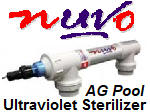
I assume that you are not referring to salt chlorination?
Otherwise what follows is not applicable. Given the fact
that you are dealing with very hard water, I would try and
use a system that allows for reduced chemical usage. Bromine
cannot be stabilized to protect it from the Sun's UV light.
Chlorine can! I would use chlorine and try to use as much
liquid chlorine, as possible, to supplement the chlorine
tablets being added with the chlorinator. You might consider
adding an
Ultraviolet Sterilizer, as it contributes no build up products
and will greatly reduce the amount of chlorine required. You
can better explore your chemistry options with the
Langelier
Index. I hope that I have been helpful.
Sincerely. Alan Schuster, 1/28/2005
► Getting
Ready For Winter?
I live in Central Illinois and have an
inground pool. It is concrete with a vinyl liner. I will
have to close it for the winter in mid-October. My calcium
hardness is very high. It is currently 380. Although, based
on information I found on your website, I watch the
Langelier Index very closely and make sure it stays in the
-0.5 to +0.5 range. My question is, should I attempt to get
the hardness level down to a more acceptable range before
closing the pool for 6 - 7 months? As a new pool owner (only
had it 1 year), I truly appreciate your website and have
learned a ton from it. I also got tired of the simple color
water tester and purchased a
ColorQ PRO 7
digital water tester from your site. Best
money I've spent this summer! Thanks!
Jeff M., Illinois, 9/5/2008
Glad to hear that the
ColorQ PRO 7 is serving you well. A hardness
level of 380 is manageable, so long as the pH is under 7.6.
Lowering the level might give you a greater margin for
error. Much will depend on the hardness of the replacement
water. You will remove some water for the winter and that
will help next spring, no matter what. I would get the pH to
7.2-7.6 and close it up. Thanks for your purchase of the
ColorQ PRO 7 Water Analyzer and I hope that this information
is helpful.
Sincerely. Alan Schuster, 9/6/2008
► Should I
Raise The Hardness?
I live in the western suburbs of
Sydney. I have an above ground pool, 35000 litres recently
installed, 2 months old. Using sand filter/chlorine. The pH
is 7.8. Total Alkalinity is 180. Total chlorine 1 & Free
Chlorine 1. Total Hardness is 80. I did a test on the tap
water used to fill the pool and the Total Hardness was 50.
From my calculations I need to add 4 kg of Calcium Chloride
to increase the calcium hardness. Given that the local water
is low in calcium will this need to be adjusted regularly.
How important is calcium hardness? Thanks.
Scott W., NSW, Australia, 4/24/2009
Inasmuch as you have a vinyl lined pool, I would opt not to
increase the calcium hardness, above the current level of 80
PPM. If the pool was masonry, I would have suggested that it
be raised to 150-200 PPM. A level of 80 PPM is the
recommended minimum for vinyl lined pools. Given the high TA
and pH, you are better off with the lower value. Adding new
water will lower the level slightly. Adding calcium
hypochlorite chlorine products will raise it slightly. I
hope that I have been helpful.
Sincerely. Alan
Schuster, 4/24/2009
► Hardness
Booster In A Vinyl Pool?
Just purchased a new liner for my
pool. My installer says calcium chloride (calcium hardness
booster) isn't necessary in vinyl pools. The people who sell
me chemicals for my pool suggest it is? What say you? Given:
all the other numbers, pH, stabilizer, etc are good. Thank
you in advance.
Michael J., Havana, FL, 5/13/2015
I say you don't raise the calcium hardness and with the
money saved, you take the wife out to dinner. Being that you
live in Florida, it is safe to assume that your water is not
soft. The suggested range for calcium hardness in vinyl
pools is 80-200 PPM and there is no need to go above 80 PPM.
As long as you keep the chemistry right, there should be no
problem. A gunite pool would have been a different matter.
Enjoy the pool.
Sincerely. Alan Schuster, 5/13/2015
► Using A
Water Softener?
Alan.
Great website! Thanks! I'm in Tucson and constantly fighting
high hardness in my in-ground pool. To combat it, could I
add a water softener to the auto-fill line for the pool?
B. R., Tucson, AZ, 8/30/2008
Absolutely!!! You want the hardness under 400 PPM. 200-250
PPM would be ideal. Test the cyanuric acid level, as well.
If it is high, you could simply pump out some water and
replace it with softened water. You could recirculate the
water, until it is under 400 PPM. Or you could hook it up,
as you planned. While nothing is better than lowering the
hardness to a manageable level, The
Magnetizer Water Conditioner is a device
that can help reduce scaling problems. I hope that this information
proves helpful.
Sincerely. Alan Schuster, 8/30/2008
►
Disappearing Calcium?
I have a city pool that's 300,000
gallons and uses gas chlorine. Its a concrete painted pool
with sand filters. The problem I have is that no matter how
much calcium I use, I can't keep 200 ppm in the pool. I can
get it there, but in a day it starts going back down. I'm
using calcium chloride like it going out of style. Help.
Dave R., 1/28/2006
The only way that calcium can leave the water is by
precipitation and that would create an obvious cloudy water
condition. If there is no cloudy water problem, I see only
three possibilities: the calcium chloride is actually
something else, the test equipment is not working properly
or is being interfered with by something in the water (a
chelate for example) or there is a significant water leak.
Of the three, a water leak seems most likely, especially, if
the source water is soft. The gas chlorine and or the
painted surface should play no role in the problem. I hope
that I have been helpful.
Sincerely. Alan Schuster,
1/28/2006
► Calcium
Nodules?
I recently had my pool replastered
with a blue color about 3 months ago. There are approx. 20
little white spots at the bottom of the pool that will not
come up with brushing. I first noticed this problem when
there were about 5 of them. The company that did the
replaster job said to keep brushing. I have been told that
the spots are calcium nodules. How do I get rid of them?
Thanks.
Terry, 4/17/2004
I wouldn't do anything without checking with the contractor.
My suggestion would be to add a dose or two of a calcium
sequestering treatment. In addition, I would try adding 1/2
pound of pH reducer in a white sock. Drop onto a spotted
area and slowly move around with a wooden pole. Hopefully,
this will dissolve the calcium deposits, if that is what
they are. Check the pH, TA and calcium hardness and adjust,
as necessary. Again, first check with the contractor,
inasmuch as the finish is only 3 months old. Also, it is
possible that the nodules are being caused by delaminations
(separation of the old and new finishes), voids or hairline
cracks in the finish. This can lead to eruptions or nodules
being formed on the surface. It does happen more frequently
in refinished pools and should eventually stop. It may be
necessary to sand down the nodules, to restore the
appearance. Discuss this with the contractor. Good luck.
Sincerely. Alan Schuster, 4/17/2004
► Hard, White
Deposits?
Hi Alan, I found your website to be
very informative, thanks for your efforts. I have an
in-ground concrete pool with plaster walls and I recently
drained it for the first time after four years to replace
some cracked tile. I noticed some algae growth underneath
the drain cover in the spa and decided to remove the drain
cover to clean it. What I discovered shocked me. Underneath
the green/black algae growth was a thick layer of white,
rock-hard mineral deposits. I then uncovered the pool drains
and they had the same white, hard deposits with hardly any
algae. The accumulation is hard as a rock, and very
difficult to remove. Is this normal? I'd hate to think how
much more may accumulate after another four years. Can you
recommend a method to loosen the deposits and clean this
off? Is there a way to prevent this from happening? Thanks
for any information you can offer.
Sergio G., El Paso, TX, 11/19/2007
There is no reason to believe that these calcium scale
deposits (that is what they seem to be) are not also present
in the pipes and in the filter. The cause of the problem is
most likely due to high levels of calcium hardness and
possibly high pH and TA. Upon refilling the pool, test for
calcium hardness and do not add any calcium hardness
booster, except enough, if necessary, to raise to raise the
level to 150 PPM. Avoid all use of calcium hypochlorite
products. Once a month add a dose of a calcium sequestering
product. Keep the pH at 7.2-7.6 and the TA at or close to
80-120 PPM. This could create conditions that can slowly
dissolve the deposits over time or at the very least help
prevent a worsening of the problem. The addition of a
Magnetic Water Conditioner might be able to help resolve
some of these scaling issues. I hope that this information
proves to be helpful.
Sincerely. Alan Schuster,
11/19/2007
► What Is A
Water Magnetizer?
I have
a pool that is located in a hard water area and as a result
I have some scaling problems. The pool service guy has
mentioned something called a magnetizer. Can you add
something more?
Ted, Tucson, AZ, 4/25/2008

Pool magnetizers or
magnetic water conditioners are strong
permanent magnets that are strapped on the return lines. It
is reported that pool water passing through the return lines
is subjected to a magnetic field, causing micro-changes in
some of the water content, as a result of an induced
positive electrical ionic charge. In short, the magnets are
said to cause some beneficial changes: reduction and
elimination of calcium scale, improvement in sanitizer
efficiency and some positive effects on the overall water
chemistry. In hard water situations, this type of product
can make a substantial improve in the water quality. No
power is required and installation should be a simple. I
hope that I have been of assistance.
Sincerely. Alan
Schuster, 4/25/2008
► White
Deposits?
We have a chlorine free pool. What can
we use to remove the white deposit. Lime? Also, could tell
me where I can get test kit:
LaMotte COPPER test kit model
EC-70 code 3619. Thank you.
No name, Hawaii, 5/7/2008
You should be able to remove the deposits, from limited
areas, with an acidic solution. The deposits are not lime
(calcium o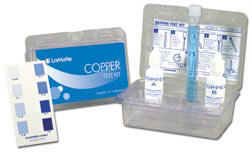 xide). Most likely the problem is due to calcium
carbonate scale deposits. Try equal parts of muriatic acid
and water: add the acid to the water and wear eye protection
and rubber gloves. If the entire is scaled over, you
probably will have to drop the pH to approximately 6 and
keep it there for a while. Use the brush to help loosen the
deposits. In addition, you should deal with the underlying
causes. Make sure that the pH is not above 7.6 and is closer
to 7.2. Keep the total alkalinity below 120 PPM, if
possible. Something tells me that your "chlorine Free" has
an Ionizer. If that is the case, the use of mineral and
scale treatments could interfere with the copper ions. Use
them only as recommended by the equipment manufacturer.
Copper Test Kits
are available in our test equipment store. the choice
includes ColorQ Test labs, individual testers and Test
Strips. I hope that I have been of
assistance.
xide). Most likely the problem is due to calcium
carbonate scale deposits. Try equal parts of muriatic acid
and water: add the acid to the water and wear eye protection
and rubber gloves. If the entire is scaled over, you
probably will have to drop the pH to approximately 6 and
keep it there for a while. Use the brush to help loosen the
deposits. In addition, you should deal with the underlying
causes. Make sure that the pH is not above 7.6 and is closer
to 7.2. Keep the total alkalinity below 120 PPM, if
possible. Something tells me that your "chlorine Free" has
an Ionizer. If that is the case, the use of mineral and
scale treatments could interfere with the copper ions. Use
them only as recommended by the equipment manufacturer.
Copper Test Kits
are available in our test equipment store. the choice
includes ColorQ Test labs, individual testers and Test
Strips. I hope that I have been of
assistance.
Sincerely. Alan Schuster, 5/8/2008
► Pool Water
Turning Milky?
I am from Columbus, OH and work for a
swimming pool company. I feel fairly knowledgeable having
been in the industry for nearly 10 years. Recently I have
had a recurring problem that I cannot solve or find the
cause of to treat. When I add soda ash to specific pools
they cloud up, not hazy but a complete cloud, almost like a
bowl of milk and the only thing that will clear it up is a
floc treatment or a poolside portable D.E. filter. This only
happens in certain pools, not all of them. The only pattern
I have noticed is that all the pools that this happens to
either have well water, old galvanized walls or poor water
treatment facilities because they are out in the country a
little more. I would assume that this problem is being
caused by the presence of minerals or metals, but I have
found nothing out of the ordinary when doing a
iron or copper
test. Do you have any idea what could be the cause and the
proper treatment to eliminate recurrence? Thank you.
Todd H., Columbus, OH, 6/23/2005
While there may be traces of iron and copper in the water,
that is not the problem. These metals would produce
discoloration and not ju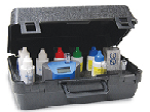 st cloudy, milky-looking water. The
addition of the soda ash raised both the pH and TA. This, in
turn, lowered the solubility of calcium and other minerals
and lead to the cloudy water. Most likely these polls have
high calcium hardness levels, as well as possible high level
of magnesium and high TDS. You should try and keep the pH
closer to 7.2-7.4. Calcium treatment can be added on a
regular basis and all use of calcium hypochlorite should
stop. When adding soda ash, add it very slowly and
distribute it around the pool perimeter. If you refer to the
page on the Langelier Index, you will gain insight to the
relationship between pH, TA and calcium. A reliable tester,
that eliminates all the color-matching and guesswork, might
help solve the mystery. A
ColorQ
all-digital photometer kit would be an ideal choice. I hope that this
information helps solve the problem.
st cloudy, milky-looking water. The
addition of the soda ash raised both the pH and TA. This, in
turn, lowered the solubility of calcium and other minerals
and lead to the cloudy water. Most likely these polls have
high calcium hardness levels, as well as possible high level
of magnesium and high TDS. You should try and keep the pH
closer to 7.2-7.4. Calcium treatment can be added on a
regular basis and all use of calcium hypochlorite should
stop. When adding soda ash, add it very slowly and
distribute it around the pool perimeter. If you refer to the
page on the Langelier Index, you will gain insight to the
relationship between pH, TA and calcium. A reliable tester,
that eliminates all the color-matching and guesswork, might
help solve the mystery. A
ColorQ
all-digital photometer kit would be an ideal choice. I hope that this
information helps solve the problem.
Sincerely. Alan Schuster, 6/23/2005
► Calcium And
Total Hardness?
My total hardness reads 500 on strip
test and my calcium hardness reads 170. What else besides
calcium is total hardness comprised of? Thanks.
Steve S., 2/21/2005
Total Hardness is comprised of calcium and magnesium
hardness. That's why the TH reading is usually higher. If
some areas magnesium can be present in the water supply. It
is much less of a problem, than is calcium hardness. Just
try and keep the pH and TA under control and avoid using
products such as calcium hypochlorite. I hope that the
information proves helpful.
Sincerely. Alan Schuster, 2/21/2005
► False Test
Reading?
Do you have any idea what could be
giving a false reading of zero calcium in my pool. The pH is
ideal and chlorine is adequate. I have a 25,000 gal pool and
have actually added 30 lbs of calcium over the last several
days and yet the calcium reading still indicates zero
(tested by my pool man, as well as a pool store). Thank you
for any response. Regards.
Randy B., 9/6/2009

There is no ready explanation. Two locations doing the
testing makes it difficult to suggest testing errors, but
that is still possible.
What are the expiration dates, on the calcium hardness
reagents, being used? The only other alternative is that
something present in the pool water is interfering with the
tests. Have the water tested for copper, as it is the number
one interference in hardness testing. In some cases, it
drags out the end-point color change giving high results and
in other colorimetric tests, in can produce low results.
Bring in a sample of your tap water and see what kind of
readings they get. In any event, I would assume that the
calcium level is close to ideal, at the very least. A better
water tester might prove useful and be a money saver too.
The ColorQ digital water analyzers eliminate the
color-matching and guesswork. I hope that I have been
helpful.
Sincerely. Alan Schuster, 9/7/2009
► Langelier
or Saturation Index?
I have been reading through some
material that was been given to me by the pool dealer. It
refers to the Langelier Index. Could you explain?
Bob M., Oregon, OH, 2/11/2004
The
Langelier or Saturation Index is a calculation that
measures the s corrosiveness or scale-forming tendencies of
swimming pool or spa water. Using data such as pH, total
alkalinity, calcium hardness and water temperature, a value
is calculated. A result of -0.5 to +0.5 is considered ideal.
Lower values are corrosive and higher values are
scale-forming. The Langelier Index helps indicate the extent
of the water chemistry correction, needed to create ideal
water conditions. I hope that I have explained
the concept and its use.
Sincerely. Alan Schuster, 2/11/2004
► Treating
Pool Calcium Hardness?
Hi Alan, I have read that you
recommend a quality mineral treatment for high calcium
levels - what is a mineral treatment?
Vicki H., Dunedin, New Zealand, 3/17/2007
Mineral Treatments are chelating or sequestering agents.
They are used to help avoid staining or discoloration due to
trace metals or to avoid the scaling and cloudy water
conditions, that are associated with high levels of calcium
hardness. You didn't supply any details, so I'll have to
speak in generalities. If the calcium hardness is over 200
PPM and below 400 PPM, it is above the ideal, but it is
manageable. Avoid the use of products containing calcium,
keep the pH at 7.2-7.6 and try to keep the total alkalinity
in the 80-120 PPM range. If the calcium hardness is above
400 PPM, the use of a mineral treatment is advised, in order
to avoid possible problems. It is, also, important to keep
the pH and TA nearer the low end of optimum. A reliable
water tester might be just what you need. The
ColorQ 2X digital
water analyzers eliminate the color-matching and guesswork.
I hope that I have been helpful.
scaling and cloudy water
conditions, that are associated with high levels of calcium
hardness. You didn't supply any details, so I'll have to
speak in generalities. If the calcium hardness is over 200
PPM and below 400 PPM, it is above the ideal, but it is
manageable. Avoid the use of products containing calcium,
keep the pH at 7.2-7.6 and try to keep the total alkalinity
in the 80-120 PPM range. If the calcium hardness is above
400 PPM, the use of a mineral treatment is advised, in order
to avoid possible problems. It is, also, important to keep
the pH and TA nearer the low end of optimum. A reliable
water tester might be just what you need. The
ColorQ 2X digital
water analyzers eliminate the color-matching and guesswork.
I hope that I have been helpful.
Sincerely. Alan Schuster, 3/17/2007
Hi Alan, thanks for your prompt reply
- we use Calcium Hypochlorite in the pool and at the moment
our calcium hardness level is 310
.
Vicki H., Dunedin, New Zealand, 3/17/2007
A level of 310 is not a serious problem. However, if you
continue to use the calcium hypochlorite the level will
continue to rise and will eventually become a problem. I
suggest that you switch to a stabilized form of chlorine.
Use the existing stock of calcium hypochlorite as a shock
treatment, until the supply is exhausted. High calcium
levels will lead to cloudy water and scale deposits on the
underwater surfaces, so it is not too late to get a handle
on the water chemistry. I hope that I've been helpful.
Sincerely. Alan Schuster, 3/17/2007
►
Dealing With Too Much
Calcium?
When I opened the pool this spring I
brought in a water sample for analysis. It was pretty good,
except for the calcium, which was 440 PPM. It is a vinyl,
inground pool, about 20,000 gallons. My household water is
not high in calcium, I had that tested too. I have been
using granular calcium hypochlorite for the past few years.
I guess that is where all the calcium came from. I did have
a few cloudy water problems last year. The sand in my filter
didn't look right, so to be on the safe side, I changed it.
My question is, what should I do about the high calcium and
can it cause a problem? Thanks.
Lou R., Middletown, NY, 6/7/2006
It is quite likely that the high level of calcium hardness
could have caused the cloudy water and may have caused the
filter sand granules to cement together. High pH and high
total alkalinity can add to and worsen the problem of high
calcium hardness. I suggest that you add a regular dose of a
quality calcium scale, to help deal with the calcium
problem. To help keep the calcium in the water from
precipitating or scaling, I suggest that you keep the pH
closer to 7.2 and the TA closer to 80 PPM. Doing this will
help keep more calcium in the water and reduce the
possibility of negative effects. In addition, I would
suggest that you stop using the calcium hypochlorite, for
daily sanitizing. Continued use will cause a further
increase in the calcium level and can lead to more and more
problems. A switch to a stabilized chlorine, for example,
will not add more calcium. Eventually, due to backwashing
and winterizing, the calcium level will decline over the
years. Test for calcium, periodically to track of the
progress. Any calcium hypochlorite, left on hand, probably
could be used for shocking purposes only. Thereafter, try
and avoid or limit the use of products containing calcium. I
hope that this information will prove helpful.
Sincerely. Alan Schuster, 6/7/2006
► Too Little
Calcium?
I just had a gunite pool put in and I
brought a sample of water in for testing. I was prepared for
a long list of chemicals, but I was surprised by the amount
of calcium increaser that was recommended. Almost 40 pounds!
It's a big pool and the water is soft. Does this make sense
to you?
Dick S., Ramsey, NJ 8/23/2011
Does it make sense? Even though you didn't provide much in
the way of details, it does make sense. You want the calcium
hardness level at 150-200 PPM. If your water is soft and the
pool big, 40 pounds sounds quite reasonable. If you don't
raise the calcium hardness level, it will be more difficult
to maintain the pH. The reason being, if you don't add the
calcium to the water - the water will dissolve or etch the
walls, until an equilibrium is reached. If you want to
avoid the pH problems and the surface etching, you should
add the calcium hardness increaser. Fortunately, the
chemical is not overly expensive and it should be a one-shot
expense. The dealer is really doing the right thing, with
the recommendation. I hope that I have been helpful.
Sincerely. Alan Schuster, 8/23/2011
► Way Too
Much Calcium?
My water supply comes from a well and
it is very hard. As a result of this, the calcium hardness
of the pool water is about 800 PPM. I've had cloudy water,
scaling and a rough deposit on the tile surfaces. Short of
having softer water trucked in (which I would like to
avoid), is there anything I can do? Looking for some help.
Thanks.
Carl R., Sedona, AZ, 3/23/2008
I agree, a calcium hardness reading of 800 PPM is too high
and problems are not unexpected. Trucking in water or having
some of the water softened are obvious solutions, that you
just might have to consider. In the meanwhile, I suggest
that you try the following steps. Add a double or triple
dose of a quality Mineral Treatment to help sequester the
calcium. Drop the pH to 7.2 and try and keep it there. The
lower pH will help keep more of the calcium in solution and
could help solve or reduce the problem. Your total
alkalinity is also probably too high. You may not be able to
do much with the TA, because it is probably not due solely
to carbonates. Lowering the pH will lower the TA, so you
should expect to see some improvement. Under no
circumstances should you use products containing calcium.
Read the labels. There are chlorine and shock treatments
that do not contain calcium. The key to success may be the
lowering of the pH to 7.2 and keeping it there. For more
information on the calcium scale, refer to the "Langelier
Index" page. I hope that this information will prove
helpful.
Sincerely. Alan Schuster, 3/24/2008
► Rough
Deposits?
We have a salt water pool. We live
just north of Dallas. It seems as though the salt is
sticking to the sides of the walls in the pool. Is this
possible? How can we fix this? A brief history on the pool.
Our pool was built this year (2004) and was finished at the
end of Aug. About a month ago, we had scale build up. We
fixed that problem with acid. Then, within the last week,
we've had an algae breakout. We've been working on fixing
this problem. Got the chemicals where they need to be; just
need to shock the pool. When I was brushing down the walls
with an exfoliating glove on my hand, I noticed how rough
all the walls were. It seems to be salt build-up. Any help
you can provide is greatly appreciated!
Dachia G., Texas, 11/22/2012
Salt shouldn't form underwater deposits like you are
describing. Most likely it is calcium scale. The factors
that lead to this problem include: high pH, high TA and high
calcium hardness. Try lowering the pH and TA to something
closer to 7.2-7.6 and 100 PPM. Adding a calcium treatment
can help remove the deposits, over time, and help keep the
salt chlorinator plates clean. I hope that the information
proves helpful.
Sincerely. Alan Schuster, 11/22/2012
► High
Calcium And TDS?
We just bought a house with a 20,000
gal. swimming pool. As it is the first time, we are
uncertain how to treat the water. The test results are: FAC
8, TAC 8, pH 7.3, total alkalinity 230, CYA 100, calcium
hardness 870, TDS 2600, negative on copper and iron. I would
appreciate if you could give me some advise on how to start
treatment. Thank you.
Walter W., Temecula, CA, 8/30/2010
A calcium hardness reading of 870 PPM is very high. I
suggest that you add a dose of a quality Calcium Treatment
on a monthly b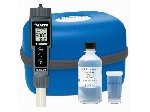 asis. In addition, try and keep the pH at
7.2-7.4 and the TA below 200 PPM. Doing this can make the
water chemistry more tolerant of the high calcium level.
Free and Total Chlorine readings of 8 are doubtful. It would
be unusual for both readings to be the same. In any event,
it is indicative of too much chlorine for proper bather
comfort. Try and keep the Free Chlorine reading at 1-3 PPM.
The Total Chlorine reading should be no more that 1 PPM
higher than the Free Chlorine. The
Total Dissolved Solids
(TDS) test results can be the real problem. You didn't include your
state, but I suspect that it is in the southwest. A TDS of
2600 PPM is very high and can lead to water quality problems
and the loss of sanitizer efficiency. It would be a good
idea to have your household water tested. If it is much
lower, you should consider doing some water replacement over
time. Good luck.
asis. In addition, try and keep the pH at
7.2-7.4 and the TA below 200 PPM. Doing this can make the
water chemistry more tolerant of the high calcium level.
Free and Total Chlorine readings of 8 are doubtful. It would
be unusual for both readings to be the same. In any event,
it is indicative of too much chlorine for proper bather
comfort. Try and keep the Free Chlorine reading at 1-3 PPM.
The Total Chlorine reading should be no more that 1 PPM
higher than the Free Chlorine. The
Total Dissolved Solids
(TDS) test results can be the real problem. You didn't include your
state, but I suspect that it is in the southwest. A TDS of
2600 PPM is very high and can lead to water quality problems
and the loss of sanitizer efficiency. It would be a good
idea to have your household water tested. If it is much
lower, you should consider doing some water replacement over
time. Good luck.
Sincerely. Alan Schuster, 8/30/2010
|
Visit The Website Stores . . . for
better informed shopping!!! |
|
 |
Shipping is FREE* . . . within
the Continental U.S.
A $9.99
handling charge will apply
to Continental U.S. Orders,
under $75.00. Orders
outside of the Continental
U.S. may require some
additional charge, based on
quantity and destination.
Most products can be
shipped World-Wide. International
and orders outside of
Continental U.S. - see
comments on the ordering
pages. |
|
 |

Major
Credit Cards and PayPal are accepted. |
|
▲
Return To Top Of Page
▲
Aqualab Systems, LLC does not
make any warranty or
representation, either expressed
or implied, regarding the
accuracy or completeness of the
information provided by this
website; nor does Aqualab
Systems., LLC. assume any
liability of any kind whatsoever
related to, or resulting from,
any use or reliance on this
information. The content of this
website should not be used, if
it is conflict with any
applicable federal, state or
local regulations or guidelines.
© Aqualab Systems, LLC. All
rights reserved










